C Exercises: Insert new node at the beginning in a doubly linked list
3. Insert at Beginning of Doubly Linked List
Write a program in C to insert a node at the beginning of a doubly linked list.
Visual Presentation:
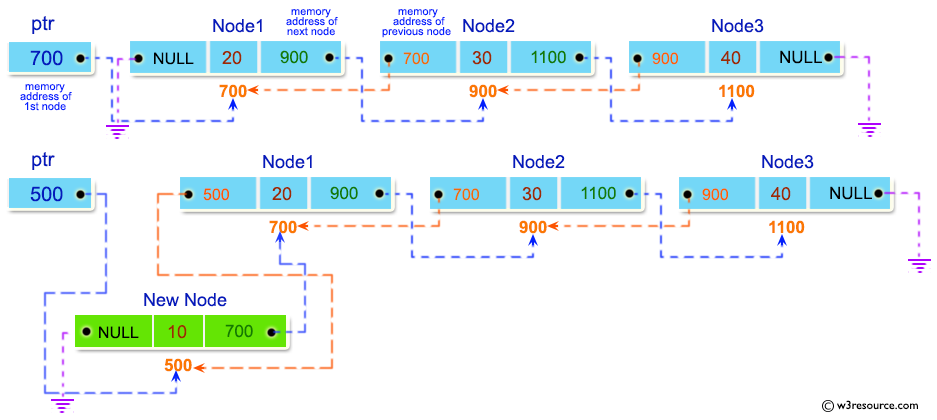
Sample Solution:
C Code:
#include <stdio.h>
#include <stdlib.h>
// Structure for a doubly linked list node
struct node {
int num;
struct node *preptr;
struct node *nextptr;
} *stnode, *ennode;
// Function prototypes
void DlListcreation(int n);
void DlLinsertNodeAtBeginning(int num);
void displayDlList(int a);
int main() {
int n, num1, a;
stnode = NULL;
ennode = NULL;
printf("\n\n Doubly Linked List: Insert new node at the beginning in a doubly linked list:\n");
printf("------------------------------------------------------------------------------------\n");
printf(" Input the number of nodes : ");
scanf("%d", &n);
DlListcreation(n); // Create a doubly linked list
a = 1;
displayDlList(a); // Display the original doubly linked list
printf(" Input data for the first node : ");
scanf("%d", &num1);
DlLinsertNodeAtBeginning(num1); // Insert a new node at the beginning
a = 2;
displayDlList(a); // Display the doubly linked list after insertion
return 0;
}
// Function to create a doubly linked list
void DlListcreation(int n) {
int i, num;
struct node *fnNode;
if (n >= 1) {
stnode = (struct node *)malloc(sizeof(struct node));
if (stnode != NULL) {
printf(" Input data for node 1 : ");
scanf("%d", &num);
stnode->num = num;
stnode->preptr = NULL;
stnode->nextptr = NULL;
ennode = stnode;
// Create nodes and link them to form the doubly linked list
for (i = 2; i <= n; i++) {
fnNode = (struct node *)malloc(sizeof(struct node));
if (fnNode != NULL) {
printf(" Input data for node %d : ", i);
scanf("%d", &num);
fnNode->num = num;
fnNode->preptr = ennode;
fnNode->nextptr = NULL;
ennode->nextptr = fnNode;
ennode = fnNode;
} else {
printf(" Memory can not be allocated.");
break;
}
}
} else {
printf(" Memory can not be allocated.");
}
}
}
// Function to insert a new node at the beginning of the doubly linked list
void DlLinsertNodeAtBeginning(int num) {
struct node *newnode;
if (stnode == NULL) {
printf(" No data found in the list!\n");
} else {
newnode = (struct node *)malloc(sizeof(struct node));
newnode->num = num;
newnode->nextptr = stnode;
newnode->preptr = NULL;
stnode->preptr = newnode;
stnode = newnode;
}
}
// Function to display the doubly linked list
void displayDlList(int m) {
struct node *tmp;
int n = 1;
if (stnode == NULL) {
printf(" No data found in the List yet.");
} else {
tmp = stnode;
if (m == 1) {
printf("\n Data entered in the list are :\n");
} else {
printf("\n After insertion, the new list is :\n");
}
while (tmp != NULL) {
printf(" node %d : %d\n", n, tmp->num);
n++;
tmp = tmp->nextptr;
}
}
}
Sample Output:
Doubly Linked List : Insert new node at the beginning in a doubly linked list :
------------------------------------------------------------------------------------
Input the number of nodes : 3
Input data for node 1 : 2
Input data for node 2 : 5
Input data for node 3 : 8
Data entered in the list are :
node 1 : 2
node 2 : 5
node 3 : 8
Input data for the first node : 1
After insertion the new list are :
node 1 : 1
node 2 : 2
node 3 : 5
node 4 : 8
Flowchart:
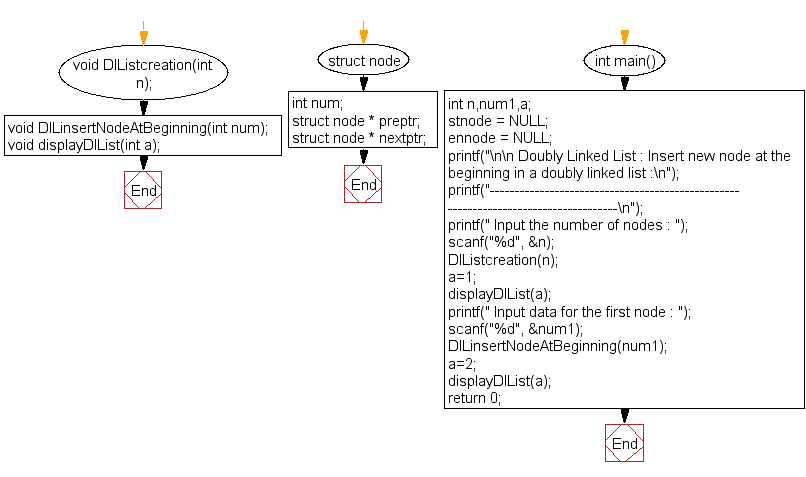
DlListcreation() :
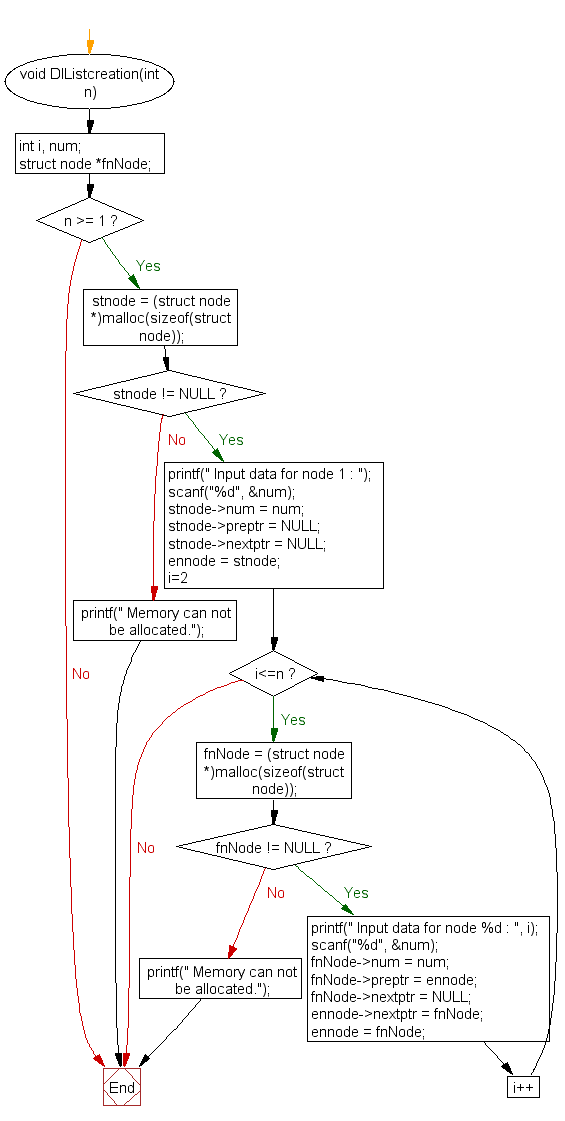
DlLinsertNodeAtBeginning() :
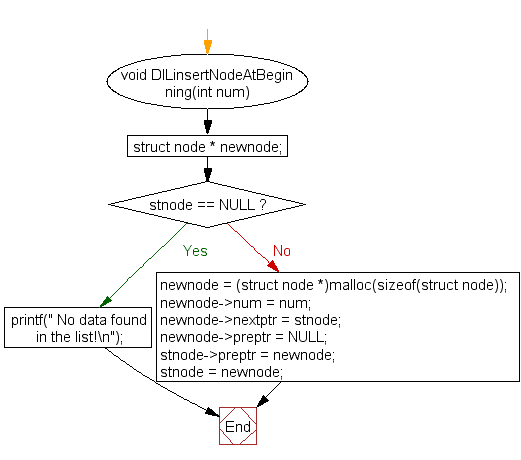
displayDlList() :
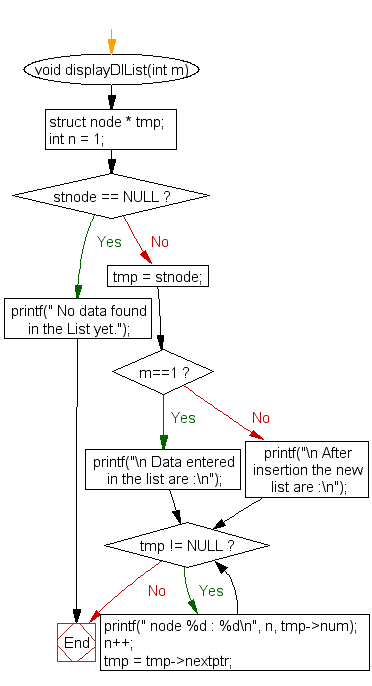
For more Practice: Solve these Related Problems:
- Write a C program to insert a node at the beginning of a doubly linked list only if its value is less than the current head’s value.
- Write a C program to insert multiple nodes at the beginning of a doubly linked list in a loop and then display the list.
- Write a C program to insert a node at the start of a doubly linked list using a recursive function to update the head pointer.
- Write a C program to insert a node at the beginning and then immediately verify the circularity of the list by counting nodes.
Go to:
PREV : Reverse Display of Doubly Linked List.
NEXT : Insert at End of Doubly Linked List.
C Programming Code Editor:
Have another way to solve this solution? Contribute your code (and comments) through Disqus.
What is the difficulty level of this exercise?
Test your Programming skills with w3resource's quiz.
